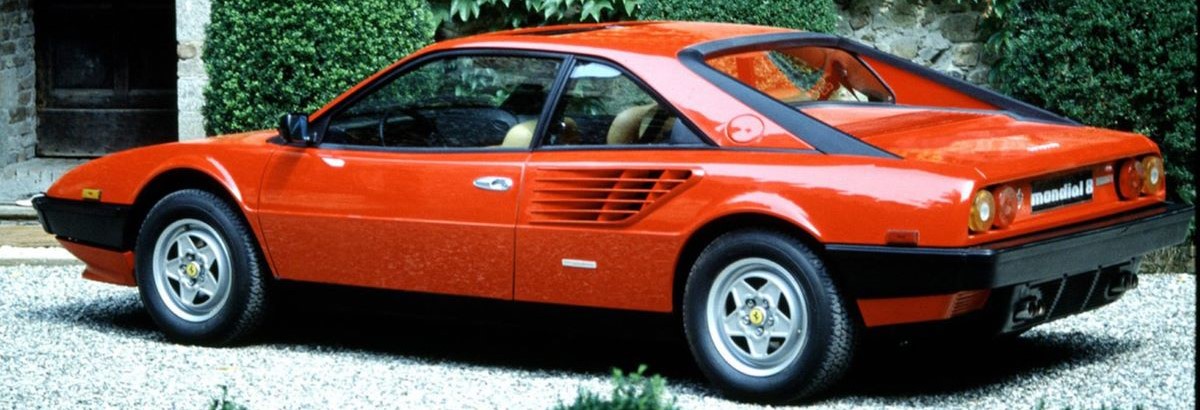
The Mondial 8 was announced at the 1980 Geneva Salon, as the replacement for the Dino 308 GT4 model. The “Mondial” part of the model title was a reference to Ferrari’s history, referring to the mid fifties sports racing model of that name, whilst the figure “8” was for the number of cylinders in the engine. It was the first Ferrari production road car to be fitted with fuel injection as standard equipment from new. The body design came from the pen of Pininfarina, and it was larger in virtually every area, apart from engine size, than its predecessor.
The cabin was certainly roomier and lighter than that of the 308 GT4, but then it should have been as the wheelbase had been increased by 100mm, whilst the front and rear tracks had grown by 35mm and 57mm respectively. The larger body added to the mass of the car by some 144 kg, which coupled to the fuel injection system resulted in somewhat leisurely performance in comparison to the 308 GT4.
As with the concurrent Ferrari 2 seat V8 models, the Mondial 8 continued the wedge body shape theme with the radiator grille beneath the front bumper. Where the 2 seat models had very slim satin black bumpers, the Mondial 8 had a much heavier wrap-around black plastic assembly incorporating driving, side and indicator light units at the front, with a similar assembly at the rear, which although balanced looked heavy in comparison. Another design feature that drew comment and controversy, were the large trapezoidal air intake grilles for the engine bay on the body sides behind the doors. This was particularly so on very early examples where they were painted satin black rather than body colour, making their presence even more obvious, especially on light coloured bodywork.
The main European market Mondial 8 models had a tubular steel chassis with factory type reference F 108 AL 100. This featured a bolted rear sub-frame section, so that the complete engine, transmission and rear suspension assembly could be dropped out of the car as a single unit, for ease of maintenance. This feature continued throughout the life of the series. The body was constructed from steel, with an aluminium front lid and engine cover. As with the concurrent 2 seat models a luggage compartment was provided in the tail of the car behind the engine bay, but on the Mondial 8 it had a separate lid.
The V8 engine of the Mondial 8 was basically the same design as that used in the 308 GT4 model, but fitted with Bosch K Jetronic fuel injection and Marelli MED 803A Digiplex electronic ignition to produce a claimed 214 bhp. It was of a 90 degree configuration, with belt driven twin overhead camshafts per bank, having a total capacity of 2926cc, with a bore and stroke of 81mm x 71mm, featuring wet sump lubrication, and bearing factory type reference F 106 B 000 for European market cars. The engine was transversely mounted in unit with the all synchromesh five speed transmission assembly, which was below, and to the rear of the engine’s sump.
The interior featured four bucket seats, those at the rear separated by a large central armrest with an elasticated oddment pocket above it. The main instruments and switches were contained in a horizontal rectangular nacelle in the dash top in front of the driver, with ancillary switches in the centre console between the seats to the rear of the open gear change gate. This panel then dropped, with a vertical face containing the radio, to a horizontal section housing a systems monitor panel, then running back to the rear ashtray between the seat belt clips.
The Mondial 8 was produced between 1980 and 1982, in the road car odd number chassis sequence in the range 31075 to 41727, with a total of 703 examples being made. It was produced in both left and right hand drive form, with variations to the basic specification for various world markets, the most obvious of these being the side marker lights on the body sides for USA market cars.
Mondial 8 Specifications and Features
- Mondial 8 (1980-1982) 703 produced
Engine
- Type………………………….rear, transverse, 90° V8
- Bore/stroke…………………..81 x 71 mm
- Unitary displacement……….365.86 cc
- Total displacement………….2926.90 cc
- Compression ratio……………8.8 : 1
- Maximum power……………..157 kW (214 hp) at 6600 rpm
- Power per litre……………….73 hp/l
- Maximum torque…………….243 Nm (24.8 kgm) at 4600 rpm
- Valve actuation……………..twin overhead camshafts per bank, two valves per cylinder
- Fuel feed……………………..Bosch K-Jetronic injection
- Ignition……………………….electronic, single spark plug per cylinder
- Lubrication…………………..wet sump
- Clutch………………………..single-plate
Chassis
- Frame………………………….tubular steel
- Front/Rear suspension….independent, unequal-length wishbones, coil springs over telescopic shock absorbers, anti-roll bar
- Brakes…………………………discs
- Transmission……………….5-speed + reverse
- Steering………………………rack-and-pinion
- Fuel tank……………………..capacity 84 litres
- Front tyres…………………..240/55 VR 390
- Rear tyres……………………240/55 VR 390
Bodywork
- Type…………………..2+2 coupé
- Length………………..4580 mm
- Width…………………1790 mm
- Height………………..1250 mm
- Wheelbase…………..2650 mm
- Front track………….1495 mm
- Rear track……………1517 mm
- Weight………………..1445 kg (dry)
Performance
- Top speed……………………230 km/h
- Acceleration
0-400 m……………………..15 sec
0-1000 m…………………….28 sec


You must be logged in to post a comment.